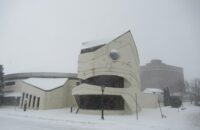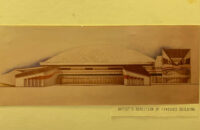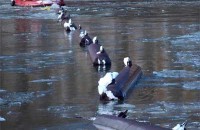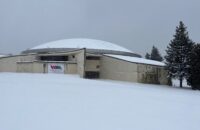Here at the Niagara Falls Reporter, we’ve often said things stink at City Hall, speaking metaphorically and meaning the wholesale waste of taxpayer money, the sweetheart deals given to developers, consultants, law firms and construction companies which are unethical, if not illegal.
But Councilman Kenny Tompkins is a literal guy.
At Monday’s City Council meeting, Mr. Tompkins asked City Administrator Nick Melson about a surfeit of skunks plaguing city residents for weeks, and he said while driving the other day, he passed five of them dead in the road.
Melson admitted there is a problem.
“There’s been an increase in skunk activity,” he said, “probably related to the weather of the last few years. We are going to see what we can do about it. We have several irons in the fire with the DEC right now. They have animal control officers at their disposal.”
But there is little if anything the city can do to resolve the smelly situation, he added.
“If a resident comes across a sick or rabid skunk, get indoors, get in your car and get to a safe place and call 911,” said Mr. Melson. “If a skunk or raccoon is on private property, you’ve got to contact the DEC or a local animal control agency. We can’t go on private property and trap an animal.”
The animals plaguing Niagara Falls are striped skunk, whose range extends from the southern half of Canada to the northernmost parts of Mexico, covering most of the continental United States. They are the most common species of skunk in North America.
Most predators, such as wolves, foxes and badgers, seldom attack skunks, presumably out of fear of being sprayed. The exceptions are reckless predators whose attacks fail once they are sprayed, dogs, and the great horned owl, which is the skunk’s only regular predator. In one case, the remains of 57 striped skunks were found in a single owl nest, according to the state Department of Environmental Conservation.
This lack of predation, combined with a gestation period of just 66 days, leads skunk populations to explode rapidly. A female can produce numerous litters every year, each consisting of up to five kits.
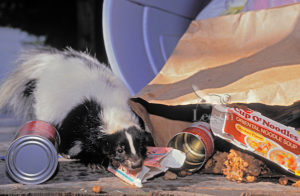
A skunk enjoys a meal from a garbage can. Skunks are experiencing a population explosion here in Niagara Falls.
As we have seen in Niagara Falls, skunks are common in residential areas. Frequent encounters with dogs and other domestic animals, and the release of the odor when a skunk is run over, have led to many myths about the removal of skunk odor. Due to the chemical composition of the spray, most of these household remedies are ineffective.
Skunks are extremely adaptable and thrive in many different habitats, as long as food and shelter are available. Because they rarely travel more than 2 miles from their established dens, a skunk will typically settle down within 2 miles of a water source.
Dens are made in tree hollows, hollowed out logs, brush piles, abandoned animal burrows, and underneath porches and other structures. And once a skunk has decided to take up residence at a given location, it is all but impossible to get rid of, other than by actually trapping.
Skunks are the primary carriers of rabies in the Midwest. Rabies is usually fatal to humans and pets unless treated immediately. If you suspect that a skunk may have rabies, do not approach it – call animal control immediately for assistance. There are two forms of rabies in skunks: the “furious” form, where skunks become aggressive, and the “dumb” form where they become unfazed by human presence. Some other signs of rabies in skunks to look out for include activity during the daytime, an unsteady or disoriented gait, drooling, and/or foaming at the mouth.
Skunks are known to release a powerful smell through their anal glands when threatened. Skunks will usually only attack when cornered or defending their young, and spraying is not the first method of defense. A skunk will growl, spit, fluff its fur, shake its tail, and stamp the ground. If the intruder does not leave, the skunk will then lift its tail and spray its famous skunk odor. A skunk’s sulfuric spray has a range of up to 10 feet, and its odor can be detected up to 1.5 miles.











